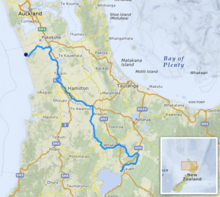
Back نهر وايكاتو Arabic نهر وايكاتو ARZ Salog Waikato BCL Вайката (рака) Byelorussian Вайката (рака) BE-X-OLD Уайкато Bulgarian Waikato Breton Riu Waikato Catalan Waikato River (suba) CEB Waikato (řeka) Czech
| Waikato River | |
|---|---|
 The Waikato River passing through Hamilton | |
 The Waikato River (interactive map) | |
| Location | |
| Country | New Zealand |
| Physical characteristics | |
| Source | |
| • location | Lake Taupō |
| Mouth | |
• location | Port Waikato |
• elevation | 0.0 metres (0 ft) |
| Length | 425 kilometres (264 mi) |
| Basin size | 13,701 km2 (5,290 sq mi) to Mercer[1] |
| Discharge | |
| • average | 327 m3/s (11,500 cu ft/s)[2] |
The Waikato River is the longest river in New Zealand, running for 425 kilometres (264 mi) through the North Island. It rises on the eastern slopes of Mount Ruapehu, joining the Tongariro River system and flowing through Lake Taupō, New Zealand's largest lake. It then drains Taupō at the lake's northeastern edge, creates the Huka Falls, and flows northwest through the Waikato Plains. It empties into the Tasman Sea south of Auckland, at Port Waikato. It gives its name to the Waikato region that surrounds the Waikato Plains. The present course of the river was largely formed about 17,000 years ago. Contributing factors were climate warming, forest being reestablished in the river headwaters and the deepening, rather than widening, of the existing river channel. The channel was gradually eroded as far up river as Piarere, leaving the old Hinuera channel through the Hinuera Gap high and dry.[3] The remains of the old course are seen clearly at Hinuera, where the cliffs mark the ancient river edges. The Waikato's main tributary is the Waipā River, which converges with it at Ngāruawāhia.
The name Waikato comes from the Māori language and translates as flowing water.[4][5] The Waikato River has spiritual meaning for various local Māori tribes, including the large Tainui, who regard it as a source of their mana, or pride. The widely respected marae of Tūrangawaewae is close to its banks at Ngāruawāhia.
For many years the Tainui tribe have sought to re-establish their links to the river after the New Zealand Wars (see Invasion of the Waikato) and the subsequent confiscations of the 1860s, and are continuing negotiations with the New Zealand government. The Tainui iwi was advised not to bring a case for the river before the Waitangi Tribunal as they would not win. An out-of-court settlement was arranged and the deed of settlement signed by the Crown and Waikato-Tainui in August 2008 settled the raupatu claim to the Waikato River, although other claims for land blocks and harbours are still outstanding. Waikato-Tainui now have joint management of the river with Waikato Regional Council.
- ^ "Environment". Environment Waikato. Retrieved 28 May 2010.
- ^ NIWA Water & soil miscellaneous publication no. 48 (1983)
- ^ McCraw, John (2011). The Wandering River: Landforms and Geological History of the Hamilton Basin. Guidebook no. 16. Geoscience Society of New Zealand. pp. 36–37.
- ^ "Waikato River". An Encyclopaedia of New Zealand. 1966.
- ^ "The Waikato: A History of New Zealand's Greatest River". Stuff.co.nz.
© MMXXIII Rich X Search. We shall prevail. All rights reserved. Rich X Search